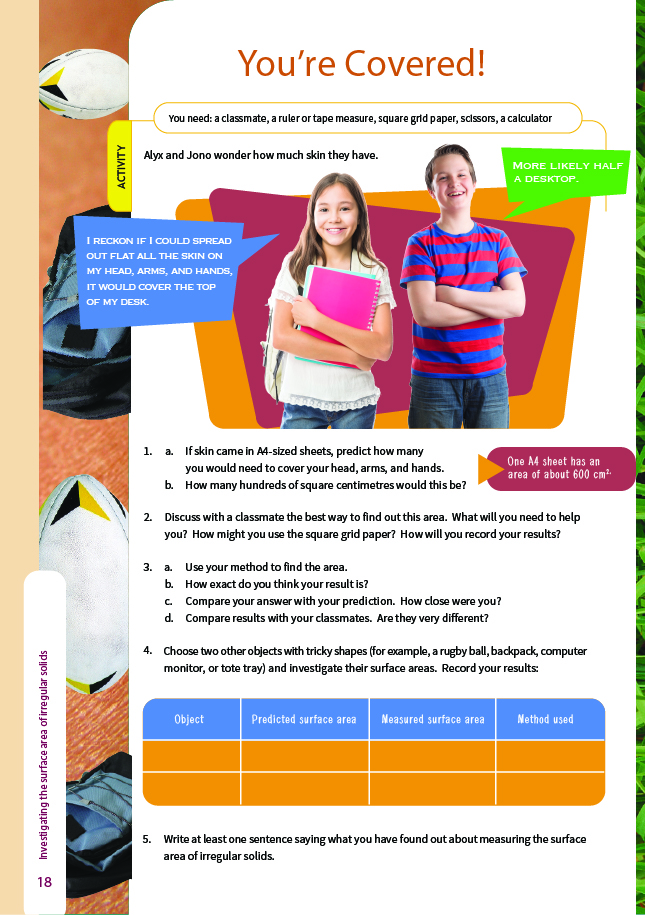This is a level 3 link measurement activity from the Figure It Out series. It relates to Stage 6 and 7of the Number Framework.
Click on the image to enlarge it. Click again to close. Download PDF (164 KB)
investigate the surface area of irregular solids
classmate
ruler or tape measure
square grid paper
FIO, Geometry and Measurement Link, You're Covered! page 18
calculator
scissors
In this activity, students grapple with measuring the surface area of irregular solids, such as their body or a computer monitor. By working through it, they come to see that, regardless of the strategies they use, the best they can do is make estimates of the areas of irregular shapes or non-flat surfaces. They may find this frustrating; if so, use this as an opportunity to explain that all measurements are actually approximations: we can only measure as accurately as our devices will allow and our eyes can read.
Students will find the tasks much easier if you give them square grid paper with squares that are 1 cm by 1 cm. They are likely to need calculators for some of the computation involved.
Introduce the activity by asking the students what area is (the size of a surface) and how it is measured (usually in square units). All measurement involves comparing some attribute of an object with a suitable unit. We can then conclude that the object possesses so many of units of that attribute. The units are usually standard units, such as those on the list below, but sometimes we use informal units (for example, when we say that something is the length of 2 cricket pitches or weighs as much as a large car). This activity begins with an informal unit for area: an A4 sheet of paper.
As part of the discussion you have with your students, talk about area and shape. Students can be inclined to think of area as an attribute possessed only by regular mathematical shapes, especially rectangular ones. All objects, no matter how irregular, have surface area. It’s just that irregular surfaces are harder to measure. This activity introduces them to challenges of this kind.
You could take the opportunity to list the everyday metric units for area:
| square millimetre (mm2) | for tiny areas |
| square centimetre (cm2) | for small areas |
| square metre (m2) | for areas such as rooms, houses, buildings, residential sections |
| hectare (100 m x 100 m or 10 000 m3) | for big areas of land, including most farms |
| square kilometre (km2) | for very large areas, such as forests, national parks, countries. |
As they work through questions 2–5, your students are likely to find that the best strategy involves cutting the centimetre square grid paper into rectangles of suitable size and taping them to the body part so that there is minimum overlap. They may find it helps to label each of the smaller rectangles used with the number of its centimetre squares. Encourage them to look for and share short cuts and strategies. There is obviously no need to measure the surface of both arms separately. Measuring one arm carefully and doubling the result is going to be much quicker and will get a result that is at least as accurate. In question 4, they should aim to divide their objects into areas that are easy to work with; for example, the sides of a tote tray or a computer monitor may have areas that can be treated as rectangles.
After the activity, encourage reflective thinking by asking questions such as these:
- What strategies did you find useful when measuring the surface areas of irregular solids?
- What did you do to try to be accurate? Could you show that your method was more accurate than another?
- What difficulties did you have? How did you overcome them?
- If two people measured the skin area of the same person, they would almost certainly get different results. Why? (Inconsistencies in defining where one region stops and another begins, differences in measuring technique, gaps and overlaps of the paper used for measuring, inaccurate counting of the 1 cm squares …)
- How accurate do you think your measuring was? How close do you think you were to the true measure?
Do you think your measurement was close enough to be of value?
Answers to Activity
1. a. Predictions will vary.
b. Predictions will vary. Multiply the number of A4 sheets by 600.
2. Methods will vary. None will give a very exact answer. Rather obviously, you only need to measure one hand (for example) and then double the result for the area of both hands. You may also find that covering the surface with small squares or rectangles of paper of known size (cut from square grid paper) gives a better result than measuring with bigger
units.
3. a. Practical task
b. Your answer won’t be very accurate, but your method may give a better result than the methods used by some of your classmates.
c.–d. Practical tasks
4. Practical tasks
5. Answers will vary. It is likely that you have found that measuring the surface area of 3-D objects is difficult if they don’t have flat surfaces and/or are irregular.
